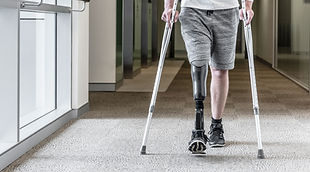

ACL Repair / Injury
We see a large amount of ACL injuries in the clinic typically due to someone jumping on them twisting their leg or from an acceleration to a quick stop after running. It is a common injury involved in all ages but predominant in the teenage and young adult demographic
Home / Conditions / ACL Repair - Injury

What is an ACL Injury
The anterior cruciate ligament (ACL) help stabilise your knee joint. This type of sprain is common among those playing sports that involve sudden stops, jumping, and landing. When an ACL injury occurs, you may hear a “pop” in the knee followed by severe pain. You may also feel that your knee is unstable, swollen, and you are unable to bear weight properly through it.
Dependant on the severity of your injury, your treatment plan will be to rest and do physiotherapy in order to regain your strength and stability. However, if your injury is severe you may need surgery to replace the torn ligament.

What are the early signs and symptoms of an ACL injury?
When injury occurs, many people hear a popping noise in their knee, but this is not always the case. More common symptoms can be:
-
Pain in your knee, and having trouble weight-bearing
-
Swelling, most likely to happen during the first 24 hours after an injury
-
Reduced range of motion as your knee is likely to be inflamed
What causes an ACL injury?
It is very common for an ACL injury to happen during sport and fitness as this puts added stress on your knee. When you damage the ligament, there is usually a complete or partial tear of the tissue. If you have a mild injury the ligament will be intact but your ligament will be stretched and this can cause increased pain.
Numerous factors can increase your risk of an ACL injury. These include:
-
Being female
-
Playing sport that requires twisting and turning
-
Wearing unsuitable footwear
-
Playing sports on artificial turf surfaces

Is surgery an option for an ACL injury?
Your surgeon may suggest you do several months of physiotherapy before having surgery. For some, physiotherapy is enough to get your pain and swelling under control and resume normal activities after a few weeks.
Surgery is definitely an option for most healthy adults who want to keep active and strong, regardless of their age.
Together with surgery, physiotherapy is the greatest chance for you a stable knee without pain and the loss of strength and movement.
Surgery to fix a torn ACL is usually done with a graft of a tendon (using your own) either from the kneecap or your hamstring. The surgery is minimally invasive because the surgeon will use an arthroscope (thin camera) and you will only have a couple of small incisions in the knee.
Surgery is solely dependant on the severity of your ACL injury. There are a few reasons why some people opt for surgery. These include:
-
You have completely torn your ACL and your knee is unstable
-
You are normally very active in sport or have a job that requires knee strength
-
Your ACL injury is affecting your quality of life
-
Apart from your ACL you have hurt other parts of your knee, such as cartilage, ligaments, or tendons. Or you have any broken bones within the knee itself
_edited.png)





